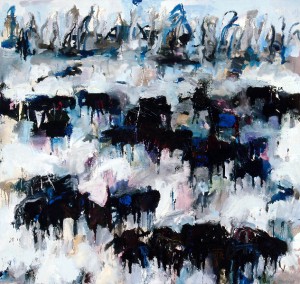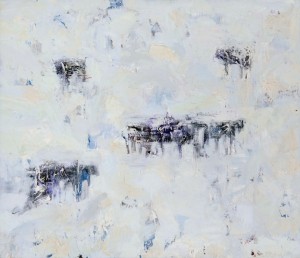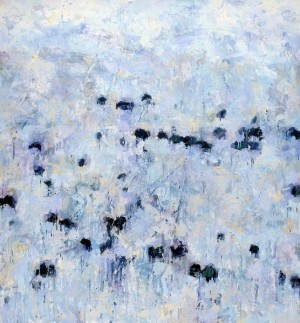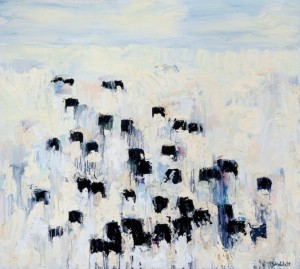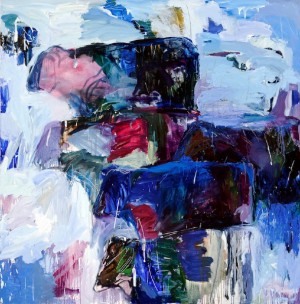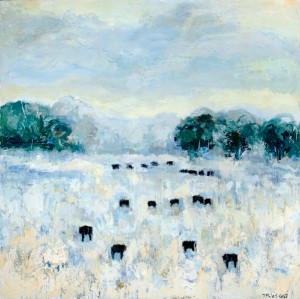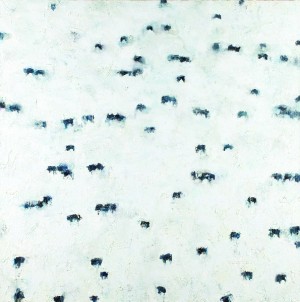
Abstract Angus – Theodore Waddell at Denver Art Museum
Theodore Waddell arrived in New York to study at the Brooklyn Museum Art School in the early 1960s, a decade after abstract expressionists like Jackson Pollock, Clyfford Still and Robert Motherwell began changing the art world. Artists of Waddell’s generation, 10 years into AbEx’s reach and ahead of pop, were either reacting against the theories – or embracing them. Waddell was only in Brooklyn for a year before returning home to Montana, being drafted into the Army and then finishing his education at Eastern Montana College. He earned his MFA from Wayne State University in Detroit in 1968.
How Waddell gleaned elements from abstract expressionism is a leitmotif of his show at the Denver Art Museum, Abstract Angus. This show of more than three decades of artistic production in paintings, drawings and prints, challenges the common perception that all western American art is created in realist style.
Waddell joined the University of Montana art faculty in 1968 teaching sculpture and design. He spent eight years living in Arlee and teaching while creating minimalist-influenced polished steel sculptures. He left that job in 1976 and spent years ranching and painting, but rarely showing any of his works with abstract, flattened backgrounds suggesting the subtle wanderings of cattle within the landscape. But in 1982 he exhibited a group of his painting in the sales arena at the Billings livestock auction yard, and was found by a curator for the Corcoran Gallery of Art in Washington D.C., who included his works in the Second Western State Exhibition, a painting biennial. Waddell’s work was singled out in reviews by the Washington Post and New York Times and was the subject of a Newsweek article.
The exhibition at the Denver Art Museum features 27 works including Motherwell’s Angus (1994) from the DAM collection. The earliest work on display is Angus Drawing #60-A (1983) a work on paper. The most recent work is a commissioned Untitled (2012) mural-sized work that is 8 feet x 30 feet that will become part of the museum’s collection.
All of the works are of painterly forms suggestive of cows in the landscape.
“When do they stop being cows and just become marks on the paper?” Thomas Smith asks. Smith is the director of the Petrie Institute of Western American Art at the Denver Art Museum.
It’s the theme around which Smith appears to have built this exhibition, hand selecting over a two-year period paintings and works on paper that explore Waddell’s subtle shifts and changes in palette. Some of the works are more about positive and negative space, like Motherwell’s Angus #23, Angus Drawing #130 and Angus Drawing #183. Others explore the rhythms of design, such as Alder Angus #2 which harkens to Jasper Johns, Robert Rauschenberg and Cy Twombly with embedded letters and numbers and expressive mark-making.
Snow is ever-present in the works on view in Abstract Angus. Only one drawing, Willow Creek Angus Drawing #3 features yellow-tinted cottonwood trees and the barren golden browns of autumn. In the cycles of life, winter is a time of death and darkness and renewal. Waddell is interested in exploring mortality in his work. We see ghosts as faint images of what has changed, decayed or transformed in his painting.
The expansiveness of his landscape, his flattened planes of land, some with horizon line, others without give credence to the magic of not only when a black shape becomes a cow in the viewer’s mind, but of the power of suggestion found in the marks made by an artist.

